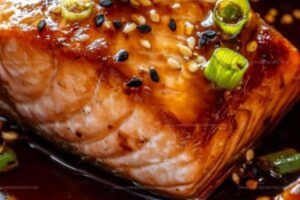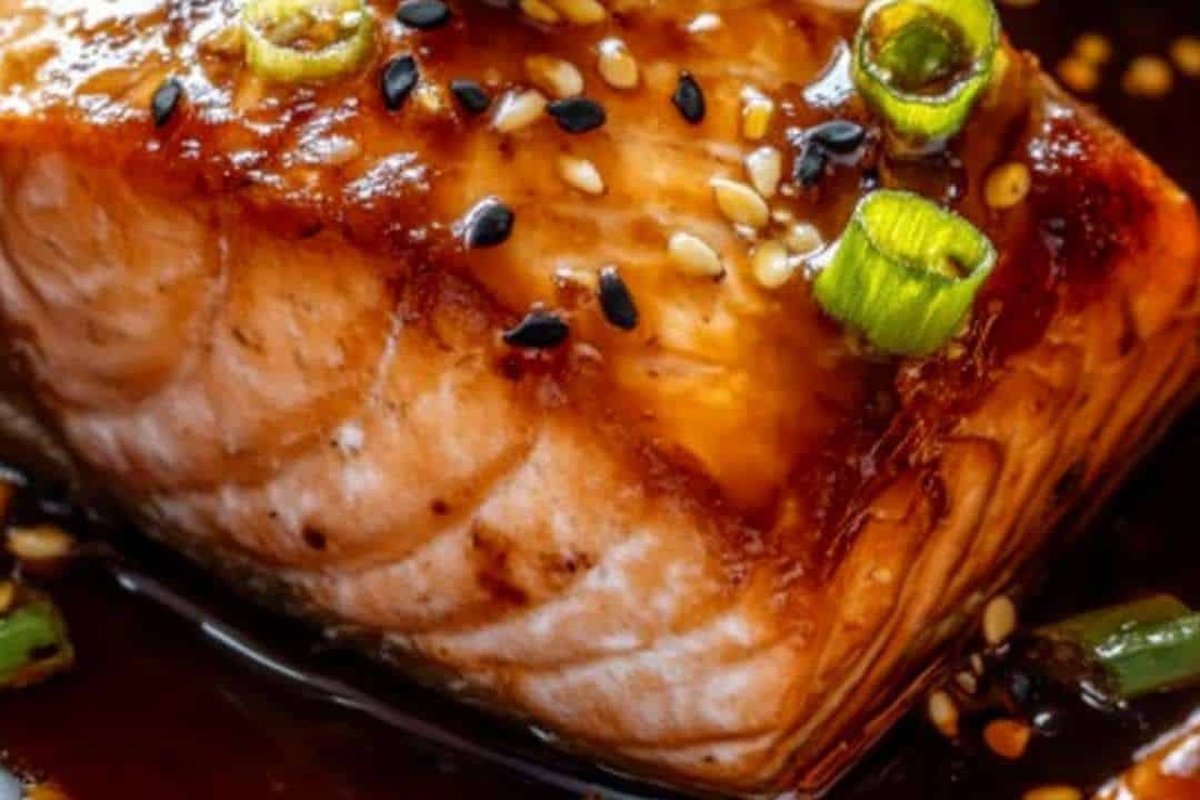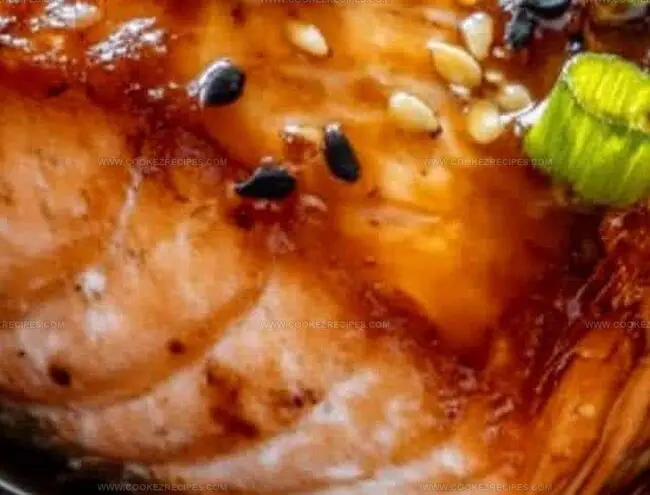Baked Teriyaki Salmon Recipe with Sticky-Sweet Glaze
Crafting a delectable baked teriyaki salmon dish brings unexpected joy to home cooking.
Marinades infuse incredible depth into each tender, flaky bite.
Weeknight dinners transform with this simple yet impressive recipe that feels like a restaurant-quality meal.
Pacific Northwest salmon provides rich, buttery flavors complemented by sweet and savory teriyaki glaze.
Japanese-inspired seasonings create a perfect balance of umami and brightness.
Home chefs can easily master this technique with just a few pantry staples.
An elegant meal awaits you in less than 30 minutes, promising deliciousness that will impress everyone at the table.
Teriyaki Salmon That’s Savory and Oven-Easy
Teriyaki Salmon (Baked) Ingredients
Main Flavoring Components:Protein Component:Aromatic Enhancers:Thickening Agent:Garnish Options:Cooking Preparation Components:Teriyaki Salmon Oven Method
Step 1: Preheat and Prepare Oven
Fire up your oven to a toasty 400°F (200°C).
Grab a baking sheet and line it with parchment paper or aluminum foil for easy cleanup.
Step 2: Whip Up Flavor-Packed Teriyaki Sauce
In a small saucepan, combine your sauce ingredients:Whisk these ingredients together and bring to a gentle simmer over medium heat.
Step 3: Create Silky Sauce Consistency
Mix cornstarch with water to form a smooth slurry.
Pour this into your simmering sauce and stir until the mixture thickens beautifully, about 1-2 minutes.
Remove from heat and let it rest.
Step 4: Position Salmon for Perfection
Lay your salmon fillets on the prepared baking sheet, skin-side down.
Generously brush each fillet with the luscious teriyaki sauce, ensuring complete coverage.
Step 5: Bake to Flaky Goodness
Slide the baking sheet into the preheated oven.
Bake for 12-15 minutes until the salmon becomes perfectly cooked and easily flakes with a gentle fork touch.
Step 6: Add Final Flavor Flourish
Once baked, give the salmon another loving brush of teriyaki sauce.
Sprinkle with sesame seeds and chopped green onions for an extra pop of flavor and visual appeal.
Step 7: Plate and Savor
Serve your teriyaki salmon piping hot alongside steamed rice and vibrant vegetables.
Enjoy the mouthwatering combination of sweet, savory, and perfectly cooked fish.
Oven Prep Tips For Teriyaki Salmon
Leftover Baked Teriyaki Salmon Tips
Teriyaki Salmon Snack Matches
Baked Teriyaki Salmon Flavor Options
FAQs
Yes, thaw frozen salmon completely in the refrigerator overnight before preparing. Pat the salmon dry with paper towels to remove excess moisture for better sauce absorption.
The salmon is done when it turns opaque and easily flakes with a fork. Internal temperature should reach 145°F (63°C). Avoid overcooking to prevent dryness.
Absolutely! You can prepare the teriyaki sauce up to 5 days in advance and store it in an airtight container in the refrigerator. Reheat gently before using.
No problem. You can substitute rice vinegar with apple cider vinegar or white wine vinegar. The sauce will still have a delicious tangy flavor.
Print
Baked Teriyaki Salmon Recipe
- Total Time: 25 minutes
- Yield: 4 1x
Description
Succulent Baked Teriyaki Salmon brings Japanese-inspired flavors dancing across your plate, promising a delightful seafood experience. Perfectly glazed and tender, this dish offers a simple yet elegant solution for weeknight dinners that satisfy both comfort and culinary elegance.
Ingredients
Protein:
- 4 salmon fillets (about 6 ounces or 170 grams each)
Sauce Ingredients:
- 1/3 cup soy sauce (low-sodium preferred)
- 1/4 cup honey or maple syrup
- 2 tablespoons rice vinegar
- 1 tablespoon sesame oil
- 2 garlic cloves, minced
- 1 teaspoon grated fresh ginger
Thickening Agents:
- 1 teaspoon cornstarch
- 1 teaspoon water
Optional Garnish:
- 1 tablespoon sesame seeds
- 2 green onions, chopped
Instructions
- Initiate oven preparation by heating to 400°F (200°C) and lining a baking sheet with parchment paper for seamless cooking and easy cleanup.
- Craft the teriyaki glaze by combining soy sauce, honey, rice vinegar, sesame oil, minced garlic, and grated ginger in a saucepan, whisking until ingredients meld together smoothly.
- Transform the sauce into a glossy consistency by creating a cornstarch slurry, then gently stirring it into the simmering liquid until it thickens and develops a luxurious sheen.
- Arrange salmon fillets on the prepared baking sheet, positioning them skin-side down to ensure even cooking and maximum flavor absorption.
- Lavishly coat each salmon fillet with the rich teriyaki glaze, ensuring complete coverage for maximum flavor penetration and caramelization.
- Transfer the salmon to the preheated oven and roast for 12-15 minutes, monitoring closely to achieve perfectly tender fish that flakes effortlessly with gentle pressure.
- Once removed from the oven, apply an additional layer of teriyaki glaze to enhance the glistening appearance and intensify the flavor profile.
- Elevate the presentation by sprinkling toasted sesame seeds and finely chopped green onions over the salmon, adding texture and visual appeal.
- Present the teriyaki salmon alongside steamed rice and vibrant vegetables, creating a harmonious and satisfying meal that delights the senses.
Notes
- Swap soy sauce with tamari or coconut aminos for a gluten-free version that maintains rich umami flavor.
- Pat salmon fillets dry before adding sauce to help achieve a crispy exterior and better sauce absorption.
- Use fresh ginger and garlic for maximum flavor complexity and aromatic intensity.
- Adjust baking time based on salmon thickness to prevent overcooking, ensuring moist and tender fish.
- Prep Time: 10 minutes
- Cook Time: 15 minutes
- Category: Dinner
- Method: Baking
- Cuisine: Japanese
Nutrition
- Serving Size: 4
- Calories: 392
- Sugar: 12 g
- Sodium: 550 mg
- Fat: 18 g
- Saturated Fat: 3 g
- Unsaturated Fat: 15 g
- Trans Fat: 0 g
- Carbohydrates: 30 g
- Fiber: 0 g
- Protein: 28 g
- Cholesterol: 85 mg




Katherine Pierce
Recipe Curator & Food Educator
Expertise
Education
Boston University Metropolitan College
Certificate Program in the Culinary Arts
Focus: French and international cuisine techniques, Hands-on culinary training with industry professionals, Food industry insights and operations
Katherine grew up believing every dish has a story. She studied the art of food at Boston University and explored the history behind it. She loves pulling easy recipes from every corner of the world and putting them at your fingertips.
When Katherine’s not writing or testing new flavors, she’s teaching cooking classes, baking colorful mooncakes, or dreaming up new ways to mix old favorites with new twists.